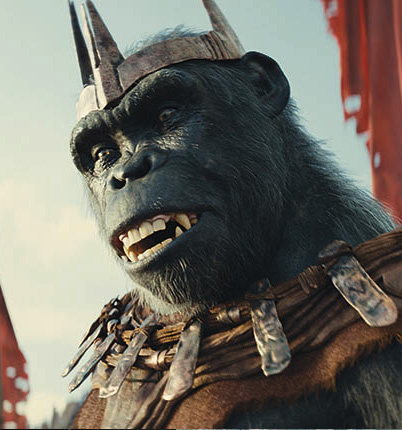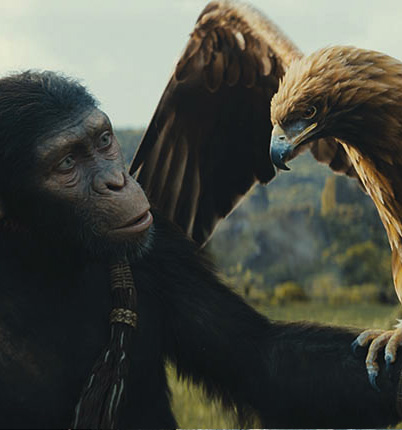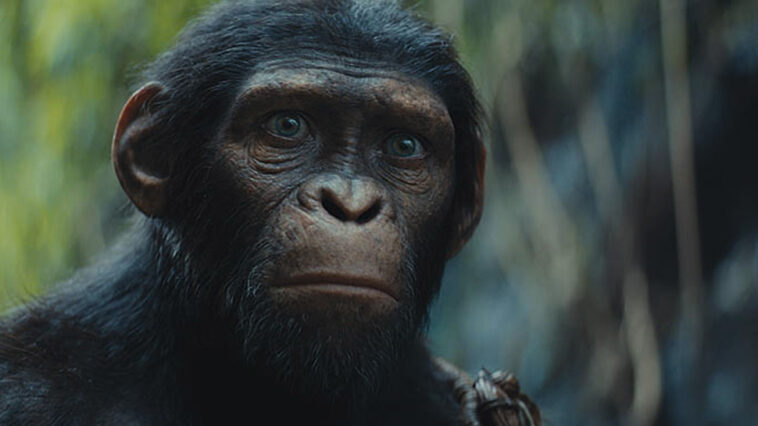Where the original Planet of the Apes pushed the boundaries of prosthetic makeup and the prequel trilogy introduced photorealistic CG apes, Kingdom of the Planet of the Apes provided an opportunity to expand upon the digital cast members and their ability to speak without relying heavily on sign language.
The story takes place approximately 300 years after War for the Planet of the Apes as Proximus Caesar attempts to harness long-lost human technology to create his own primate kingdom. “This is about apes all the way through. The world is upside down and the humans are now these feral little creatures running around in the background,” states director Wes Ball, who was responsible for The Maze Runner franchise and is laying the groundwork for another Planet of the Apes trilogy. “We’re going to have more talking, and the apes are going to be acting more human-like because this is marching towards to the 1968 version where they are full-on walking on two legs.”
Continues Ball, “In terms of the visual effects of it all, you’ve got all of these amazing new developments that Wētā FX has done from Avatar: The Way of Water. Rise of the Planet of the Apes came on the heels of the performance capture leap forward. [We looked at] all the tech on Avatar Wētā FX had provided, and then we took it outside,” Visual Effects Supervisor Erik Winquist recalls. “From a hardware and technology standpoint, one of the improvements is now we’re using a stacked pair of stereo facial cameras instead of single cameras, which allows us to reconstruct an actual 3D depth mesh of the actor’s face. It allows us to get a much better sense of the nuance of what their face was doing.”

“From a hardware and technology standpoint, one of the improvements is now we’re using a stacked pair of stereo facial cameras instead of single cameras, which allows us to reconstruct an actual 3D depth mesh of the actor’s face. It allows us to get a much better sense of the nuance of what their face was doing.”
—Erik Winquist, Visual Effects Supervisor


Avatar: The Way of Water used old Machine Vision cameras that straddled the matte box on the main hero camera. “We did the same thing here in every instance, and it has allowed us to get a wider field of view and also a stereo mesh of whatever was standing in front of the camera,” Winquist explains. “If we need to harness that to help reconstruct the body performance of what the actors are doing, we can use that as an aid in terms of reconstructing what their limbs were doing that we couldn’t see off-screen from the main camera. Unlike the previous three films, this was shot with Panavision anamorphic lenses, so we no longer had that extra real estate above and below the frame lines like we did when we were shooting spherical, so that came in handy there. The other obvious thing that we took from Avatar: The Way of Water was the water itself. There were literally two shots in War for the Planet of the Apes where Caesar goes over the waterfall and winds up in the river down below. Those shots were definitely a struggle back in 2017 when that was done. Since then, with all of the additional tech that had to be done for Avatar: The Way of Water to deal with the interaction of hair and fluids, we could leverage that in this movie to great affect.”


Different cultures were represented by various ape clans. “Originally, we were talking about they having their own coins but that never came necessary in our narrative,” Production Designer Daniel T. Dorrance explains. “The Eagle Clan is primitive and lives off of the land. Nothing from the human environment. Everything is organic, made from the earth. They never went beyond the Forbidden Zone because they knew once you’re in the human world, there’s danger. For when we’re traveling, for the most part, we did all of these different things along the way. Noa meets Raka, and we’re starting to see human elements creep in a little bit. Raka is a picker and has little stashes of things around his place. As we get to the end of the movie with Proximus Caesar, we see that they’re living off the human environment. Everything is made of metal that they’ve taken from the ship, and they have turned it into things that help them to survive.” Village scenes were not straight forward. “You can only capture five people at a time,” Dorrance reveals. “Normally, in Maze Runner we have a street full of people, and they’re crossing the street doing the things that extras usually do. None of that happened. You’re sitting in front of a whole village set with everything that we dressed in that would normally be people chopping wood or whatever it might be. Those things were there, but no one was doing them on the day. All of that was done in post.”
